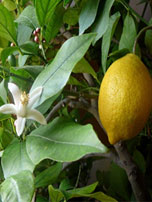SHAHEED KARTAR SINGH SARABHA AYURVEDIC MEDICAL COLLEGE & HOSPITAL
Affiliated to Guru Ravidas Ayurved University, Hoshiarpur Punjab
Affiliated to Guru Ravidas Ayurved University, Hoshiarpur Punjab

Botanical Name : Citrus limon (Linn.) Burm.f.
Family : Rutaceae
Introduction :
This drug commonly used in Rasa sãstra. it coming under Amla varga. Its juice is considered to be Vyadhi-viparitarthakãri cikitsa in Amlapittai Süla.this herb have high Vitamin -C value.
Scientific classification: The lime belongs to the family Rutaceae. It is classified as Citrus aurantifolia. The Perrine lemon is classified as Citrus limon aurantifolia.
Names in different Indian languages :
English : Lemon
Hindi : Nimbu
Kannada : Limbe
Malayalam : Chereunarakam
Sanskrit : Jambira
Tamil : Periya elumuchhai
Telugu : Peddanimma ,nimma
Unani : Utraj
Synonyms :
Jambh, Jambhir, Jaamphal, Nimbu, Nimbuka, Naaranga, Limpaka, Dantashatha, Airaavata, Neebu (bigger var.).
Classification according to Charaka, Susrutha & Vagbhata :
Charaka
Phala Varga, Amla varga
Susrutha
Phala Varga
Vagbhata
Phala Varga
Varieties & adulterants – (CV – controversy, AD – adulterants) :
(1) Vana Jambira (wild lime)-. Atalantia malabarica (Rafin.) Tanaka or A. monophylla correa.
(2) Jambira (lime)— Citrus aurantifolla (Christm) Single or mediaca Linn. Var. acida watt.
(3) MistanimbUphaja (sweet lime)— Citrus limetta Risso.
(4) Naranga (orange)— Citrus reticulata Blanco or C. aurantium Linn. Var. aurantium.
(5) Madhukarkati (pummelo or paradise apple)— Citrus maxima (Burm). Merr.
(6) Nimbuka (lemon)— Citrus limon (L.) Burm. f
(7) Bijapüra (citron)— Citrus medica Linn. or C. niedica var. medica Watt.
(8) Svalpa Jambirikã
(9) Mistaphala
1 . Citrus pseudolimon (Galgal)
2. Citrus nobilis XC. Deliciosa (kinnow)
3. Citrus aurantium (khatta)
4. Citrus medica (baramasi/ bara nimbu)
5. Citrus jhambiri (jhambiri)
6. Citrus aurantifolia (nimbu)
Morphology :
A straggling, bushy, small tree, 3-4 m. high, with thorny branches.
Leaves—simple, alternate, ovate, petiole margined or winged.
Flowers-small, white or pinkish, sweet-scented.
Fruit- oblong or ovoid, usually with a nipple-shaped extremely, bright yellow, rind thick; pulp acid, pale yellow
Distribution & Habitat :
All over India
Chemical constituents :
Fruit juice contains 7 to 10% citric acid, phosphoric acid, malic acid, citrate, sugar. mucin and alkaloids. hesperidin. Abscisic acid, abscisin II, auxin, limonin, limonene, poncirin from fruits.
Properties :
Rasa Amla, Katu
Guna Laghu, Tiksna
Virya Usna
Vipaka Amla
Karma : Vãta-Kapha hara, Dipana-pacana, Caksusya, ruchyam, varnyam , tarpanam antiscorbutic, carminative, stomachic, antihistaminic, antibacterial.
Indication :
Krimi, coughs, colds, fever, scurvy, hiccoughs, Cough, ulcer, skin disease
Part used :
Fruit
Dosage :
juice 10-15 ml
Internal use :
Digestive system : being an antidisetic, palatable, appetizer, digestant, laxative and collagogue, it is useful in emesis. distaste, anorexia, indigestion, constipation, abdominal distension and liver disorders
Circulatory system : As it is a cardiac tonic, antihaemorrhagic and blood purifier
Respiratory system : it is used in cough induced by vata and kapha. Lime juice is put in nose in epitasis.
Urinary system : Diuretic and reduces uric acid, Mixture of lime juice and yavakshar reduces dysuria and uric acid.
Skin Being diaphoretic. it is used in various skin disorders.
Temperature useful in fever and burning sensations.
Therapeutic Uses:
(I) Karnasula-The oil prepared by using lime juice is useful .
(2) Amla Pitta— Fresh juice of Jambira may be given in the evening (C.D.)
